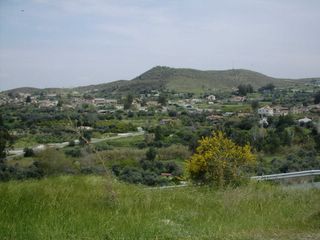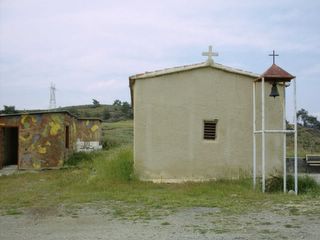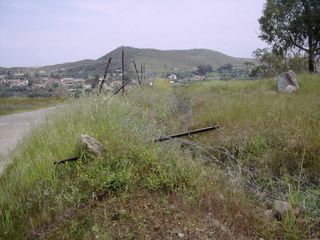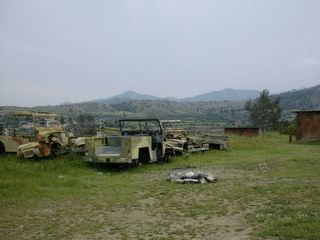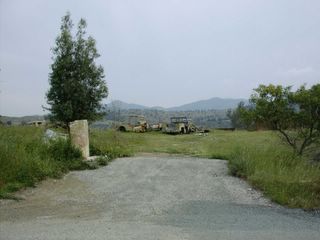I decided to officially archive this blog on the day my DPhil was confirmed. But I have waited for the electronic publication of my thesis, Interrogating Archaeological Ethics in Conflict Zones: Cultural Heritage Work in Cyprus, to announce the archiving. From now on, I will blog at Conflict Antiquities.
Saturday, August 27, 2011
Wednesday, December 16, 2009
Ayios Epiphanios: abandoned village, destroyed
Ayios Epiphanios: abandoned village, destroyed
[Thanks to Dave S's comment on the Evretou photo blog, I will try to give each site photo blog a proper introduction; until then, I'll cross-post the introductory posts from Cultural Heritage in Conflict (or samarkeolog).]
Ayios Epiphanios was one of the first places I visited as a "negative heritage tourist"; I and a couple of other archaeologists toured several sites, "mine" also including the twin villages of Kato and Pano Koutraphas. When I stated that the abandoned village of Ayios Epiphanios had been destroyed, some archaeologists agreed, but others vehemently denied it.
Those who denied that the village had been destroyed could not be convinced with the only evidence I had at the time, which was documentation by 'TRNC sources' (the northern administration's official narratives); these preliminary photographs are the first pieces of non-partisan evidence I have that I can use in the site's interpretation.
Of many, there are two sites Jack C. Goodwin (1978: 166) identified as Ayios Epiphanios that must not be confused. The first is a 'locale' half a mile north-west of Pano Phlasou, where there is a church also named after Ayios Epiphanios, but, otherwise, '[f]ields [and] olives; no habitation'. The second is a 'village' called 'Ayios Epiphanios-Solea' or 'Aybidfan' - or, according to Karaokcu (2003c), 'Aybifan' or 'Aybirfan' - half a mile north-west of Kato Phlasou.
In the village of Ayios Epiphanios, there is a church called Ayia Mavri; the village had had a population of '66(T [Turkish Cypriots])' at the time of the Troubles and had been 'the birthplace of Rauf Denktash, President of the so-called Turkish Federated State of Cyprus', whose 'fellow-villagers were transferred to the TA occup [Turkish army-occupied] part of Cyprus under UNFICYP escort in 1975' (Goodwin, 1978: 166).
I didn't see the name of the church displayed, but as the photographs clearly show (albeit buried) habitation, I can only assume that this is the village of Ayios Epiphanios. Reading the description of the site by Karaokcu (2003c - emphasis added), it fits exactly and is worth quoting at length:
Since, as Goodwin (1978: 166) noted, Denktash 'swore to return to his vill [village] one day, meaning at the time that he meant to retire back home', the Greek Cypriot nationalists' particular desire to destroy the leader of the enemy's birthplace and to leave him no home to retire to would add to their general desire to leave the enemy no village to return to and to erase the memory of their existence.
Goodwin, J C. 1978: An historical toponymy of Cyprus. Nicosia: Jack C. Goodwin.
Karaokcu, H. 2003c: "The present conditions of Turkish Cypriot villages in south Cyprus 3". Diplomatic Observer. Available at: http://www.diplomaticobserver.com/news_read.asp?id=838
(The quotes are original, although their formatting may have been changed to make them easy to read in a blog.)
[This was originally posted on samarkeolog on 11th January 2007.]
[Thanks to Dave S's comment on the Evretou photo blog, I will try to give each site photo blog a proper introduction; until then, I'll cross-post the introductory posts from Cultural Heritage in Conflict (or samarkeolog).]
Ayios Epiphanios was one of the first places I visited as a "negative heritage tourist"; I and a couple of other archaeologists toured several sites, "mine" also including the twin villages of Kato and Pano Koutraphas. When I stated that the abandoned village of Ayios Epiphanios had been destroyed, some archaeologists agreed, but others vehemently denied it.
Those who denied that the village had been destroyed could not be convinced with the only evidence I had at the time, which was documentation by 'TRNC sources' (the northern administration's official narratives); these preliminary photographs are the first pieces of non-partisan evidence I have that I can use in the site's interpretation.
Of many, there are two sites Jack C. Goodwin (1978: 166) identified as Ayios Epiphanios that must not be confused. The first is a 'locale' half a mile north-west of Pano Phlasou, where there is a church also named after Ayios Epiphanios, but, otherwise, '[f]ields [and] olives; no habitation'. The second is a 'village' called 'Ayios Epiphanios-Solea' or 'Aybidfan' - or, according to Karaokcu (2003c), 'Aybifan' or 'Aybirfan' - half a mile north-west of Kato Phlasou.
In the village of Ayios Epiphanios, there is a church called Ayia Mavri; the village had had a population of '66(T [Turkish Cypriots])' at the time of the Troubles and had been 'the birthplace of Rauf Denktash, President of the so-called Turkish Federated State of Cyprus', whose 'fellow-villagers were transferred to the TA occup [Turkish army-occupied] part of Cyprus under UNFICYP escort in 1975' (Goodwin, 1978: 166).
I didn't see the name of the church displayed, but as the photographs clearly show (albeit buried) habitation, I can only assume that this is the village of Ayios Epiphanios. Reading the description of the site by Karaokcu (2003c - emphasis added), it fits exactly and is worth quoting at length:
There were no signs showing the village. There was no need for this, because during the 1960s, when the Turkish Cypriots were forced to migrate from this village due to the pressures imposed upon them this small, pretty village had been completely razed to the ground by the Greek Cypriots.As for the church, 'built by the Greek Cypriots while they were using the military camp' (Karaokcu, 2003c), this would complement and corroborate the idea that the bulldozed village was aggressively reshaped, as the "empty" land was refilled with military material, then Christianised, made Greek Cypriot (Orthodox).
Afterwards, the Greek Cypriots turned this area into a military camp and then later left this camp. In its place, all we found were abandoned military vehicles, exploded smoke grenades, barbed wire and trenches. There wasn't a single house in Aybifan. We even found it difficult to find the remains of the foundations of any houses.
Since, as Goodwin (1978: 166) noted, Denktash 'swore to return to his vill [village] one day, meaning at the time that he meant to retire back home', the Greek Cypriot nationalists' particular desire to destroy the leader of the enemy's birthplace and to leave him no home to retire to would add to their general desire to leave the enemy no village to return to and to erase the memory of their existence.
Goodwin, J C. 1978: An historical toponymy of Cyprus. Nicosia: Jack C. Goodwin.
Karaokcu, H. 2003c: "The present conditions of Turkish Cypriot villages in south Cyprus 3". Diplomatic Observer. Available at: http://www.diplomaticobserver.com/news_read.asp?id=838
(The quotes are original, although their formatting may have been changed to make them easy to read in a blog.)
[This was originally posted on samarkeolog on 11th January 2007.]
Monday, January 01, 2007
Subscribe to:
Comments (Atom)



